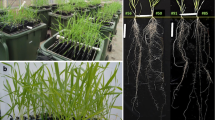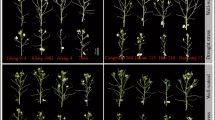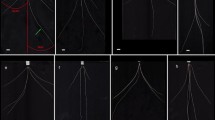Abstract
Root system characteristics are of fundamental importance to soil exploration and below-ground resource acquisition. Root architectural traits determine the in situ space-filling properties of a root system or root architecture. The growth angle of root axes is a principal component of root system architecture that has been strongly associated with acquisition efficiency in many crop species. The aims of this study were to examine the extent of genotypic variability for the growth angle and number of seminal roots in 27 current Australian and 3 CIMMYT wheat (Triticum aestivum L.) genotypes, and to quantify using fractal analysis the root system architecture of a subset of wheat genotypes contrasting in drought tolerance and seminal root characteristics. The growth angle and number of seminal roots showed significant genotypic variation among the wheat genotypes with values ranging from 36 to 56 (degrees) and 3 to 5 (plant−1), respectively. Cluster analysis of wheat genotypes based on similarity in their seminal root characteristics resulted in four groups. The group composition reflected to some extent the genetic background and environmental adaptation of genotypes. Wheat cultivars grown widely in the Mediterranean environments of southern and western Australia generally had wider growth angle and lower number of seminal axes. In contrast, cultivars with superior performance on deep clay soils in the northern cropping region, such as SeriM82, Baxter, Babax, and Dharwar Dry exhibited a narrower angle of seminal axes. The wheat genotypes also showed significant variation in fractal dimension (D). The D values calculated for the individual segments of each root system suggested that, compared to the standard cultivar Hartog, the drought-tolerant genotypes adapted to the northern region tended to distribute relatively more roots in the soil volume directly underneath the plant. These findings suggest that wheat root system architecture is closely linked to the angle of seminal root axes at the seedling stage. The implications of genotypic variation in the seminal root characteristics and fractal dimension for specific adaptation to drought environment types are discussed with emphasis on the possible exploitation of root architectural traits in breeding for improved wheat cultivars for water-limited environments.






Similar content being viewed by others
References
Araki H, Iijima M (2001) Deep rooting in winter wheat: rooting nodes of deep roots in two cultivars with deep and shallow root systems. Plant Prod Sci 4:215–219
Bengough AG, Gordon DC, Al-Menaie H, Ellis RP, Allan D, Keith R, Thomas WTB, Forster BP (2004) Gel observation chamber for rapid screening of root traits in cereal seedlings. Plant Soil 262:63–70
Berntson GM (1994) Root systems and fractals: how reliable are calculations of fractal dimensions? Ann Bot 73:281–284
Berntson GM (1997) Topological scaling and plant root system architecture: developmental and functional hierarchies. New Phytol 135:621–634
Bouma TJ, Nielsen KL, Van Hal J, Koutstaal B (2001) Root system topology and diameter distribution of species from habitats differing in inundation frequency. Funct Ecol 15:360–369
Cooper M, Jensen NM, Carroll BJ, Godwin ID, Podlich DW (1999) QTL mapping activities and marker assisted selection for yield in the Germplasm Enhancement Program of the Australian Northern Wheat Improvement Program. In: Ribaut J-M, Poland D (eds) Molecular approaches for the genetic improvement of cereals for stable production in water-limited environments. CIMMYT, El Batan, Mexico, pp 120–127
DAFWA (Department of Agriculture and Food Western Australia) (2007) Wheat variety guide 2007 Western Australia. Bulletin 4704, ISSN 1833–7236
Eastwood R (2001) Wheat varieties 2001. Victorian Department of Primary Industry, Horsham, Australia
Eghball B, Settimi JR, Maranville JW, Parkhurst AM (1993) Fractal analysis for morphological description of corn roots under nitrogen stress. Agron J 85:287–289
Eshel A (1998) On the fractal dimensions of a root system. Plant Cell Environ 21:247–251
Fitter AH (1987) An architectural approach to the comparative ecology of plant root systems. New Phytol 106:61–77
Fitter AH (2002) Characteristics and functions of root systems. In: Waisel Y, Eshel A, Kafkafi U (eds) Plant roots: the hidden half. Marcel Dekker, New York, USA, pp 249–259
Fitter AH, Stickland TR (1991) Architectural analysis of plant root systems 2. Influence of nutrient supply on architecture in contrasting plant species. New Phytol 118:383–389
Fitter AH, Stickland TR (1992) Fractal characterization of root system architecture. Funct Ecol 6:632–635
Fritsch R (1977) Über morphologische Wurzelmerkmale bei Triticum L. und Aegilops L. (Gramimeae). Kulturpflanze 25:45–70
Gregory PJ (1989) The role of root characteristics in moderating the effects of drought. In: Drought resistance in cereals. Proceedings of a symposium held in Cairo, Egypt, 28–30 November 1988, pp 141–150
Gregory PJ (1994) Root growth and activity. In: Boote KJ, Bennett JM, Sinclair TR, Paulsen GM (eds) Physiology and determination of crop yield. ASA, CSSA, and SSSA, Madison, WI, pp 65–93
Gregory PJ, McGowan M, Biscoe PV, Hunter B (1978) Water relations of winter wheat. 1. Growth of the root system. J Agric Sci Camb 91:91–102
Gregory PJ, Tennant D, Belford RK (1992) Root and shoot growth, and water and light use efficiency of barley and wheat crops grown on a shallow duplex soil in a Mediterranean-type environment. Aust J Agric Res 43:555–573
Hammer GL (2006) Pathways to prosperity: breaking the yield barrier in sorghum. Agricultural Science 19(2):16–22
Hartigan JA (1975) Clustering algorithms. Wiley, New York
Hoad SP, Russell G, Lucas ME, Bingham IJ (2001) The management of wheat, barley, and oat root systems. Adv Agron 74:193–246
Hurd EA (1968) Growth of roots of seven varieties of spring wheat at high and low moisture levels. Agron J 60:201–205
Kato Y, Abe J, Kamoshita A, Yamagishi J (2006) Genotypic variation in root growth angle in rice (Oryza sativa L.) and its association with deep root development in upland fields with different water regimes. Plant Soil 287:117–129
Kirkegaard JA, Lilley JM, Howe GN, Graham JM (2007) Impact of subsoil water use on wheat yield. Aust J Agric Res 58:303–315
Klepper B (1992) Development and growth of crop root systems. In: Hatfield JL, Stewart BA (eds) Limitations to plant root growth. Adv Soil Sci 19, pp 1–25
Klepper B, Belford RK, Rickman RW (1984) Root and shoot development in winter wheat. Agron J 76:117–122
Kutschera L (1960) Wurzelatlas mitteleuropaeischer Ackerunkraeuter und Kulturpflanzen. DLG Verlag, Frankfurt am main, Germany
Liao H, Rubio G, Yan X, Cao A, Brown KM, Lynch JP (2001) Effect of phosphorus availability on basal root shallowness in common bean. Plant Soil 232:69–79
Liao M, Fillery IRP, Palta JA (2004) Early vigorous growth is a major factor influencing nitrogen uptake in wheat. Funct Plant Biol 31:121–129
Liao M, Palta JA, Fillery IRP (2006) Root characteristics of vigorous wheat improve early nitrogen uptake. Aust J Agric Res 57:1097–1107
López-Castañeda C, Richards RA (1994) Variation in temperate cereals in rainfed environments. I. Grain yield, biomass and agronomic characteristics. Field Crops Res 37:51–62
Ludlow MM, Muchow RC (1990) A critical evaluation of traits for improving crop yields in water-limited environments. Adv Agron 43:107–153
Lush D (2007) Wheat varieties for Queensland 2007. Queensland Department of Primary Industries and Fisheries, PRO7-2651, Brisbane, Australia
Lynch J (1995) Root architecture and plant productivity. Plant Physiol 109:7–13
Lynch JP, Brown KM (2001) Topsoil foraging – an architectural adaptation of plants to low phosphorus availability. Plant Soil 237:225–237
Lynch J, van Beem JJ (1993) Growth and architecture of seedling roots of common bean genotypes. Crop Sci 33:1253–1257
Mac Key J (1979) Wheat domestication as a shoot: root interrelation process. In: Ramanujam S (ed) Proceedings of the fifth international wheat genetics symposium. Volume 2, Session IX. Genetics of adaptation, production and stress physiology. Indian Society of Plant Breeding and Genetics, New Delhi, India, pp 875–890
Mandelbrot BB (1983) The fractal geometry of nature. Freeman, New York
Manschadi AM, Christopher J, deVoil P, Hammer GL (2006) The role of root architectural traits in adaptation of wheat to water-limited environments. Funct Plant Biol 33:823–837
Manske GGB, Vlek PLG (2002) Root architecture – wheat as a model plant. In: Waisel Y, Eshel A, Kafkafi U (eds) Plant roots: the hidden half. Marcel Dekker, New York, USA, pp 249–259
Manske GGB, Ortiz-Monasterio JI, Ginkel MV, González RM, Rajaram S, Molina E, Vlek PLG (2000) Traits associated with improved P-uptake efficiency in CIMMYT’s semidwarf spring bread wheat grown on an acid Andisol in Mexico. Plant Soil 221:189–204
Masi CEA, Maranville JW (1998) Evaluation of sorghum root branching using fractals. J Agric Sci Camb 131:259–265
McPhee K (2005) Variation for seedling root architecture in the core collection of pea germplasm. Crop Sci 45:1758–1763
McRae FJ, McCaffery DW, Matthews PW (2007) Winter crop variety guide. New South Wales Department of Primary Industries, ISSN 1328-9535
Nakamoto T, Oyanagi A (1994) The direction of growth of seminal roots of Triticum aestivum L. and experimental modification thereof. Ann Bot 73:363–367
Nielsen K, Lynch J, Weiss H (1997) Fractal geometry of bean root systems: correlations between spatial and fractal dimension. Am J Bot 84:26–33
Nielsen KL, Miller CR, Beck D, Lynch JP (1999) Fractal geometry of root systems: field observations of contrasting genotypes of common bean (Phaseolus vulgaris L.) grown under different phosphorus regimes. Plant Soil 206:181–190
Nix HA (1975) The Australian climate and its effect on grain yield and quality. In: Lazenby A, Matheson EM (eds) Australian field crops, wheat and other temperate cereals. Angus and Robertson, Sydney, pp 183–226
O’Brien L (1979) Genetic variability of root growth in wheat (Triticum aestivum L.). Aust J Agric Res 30:587–595
Olivares-Villegas JJ, Reynolds MP, McDonald GK (2007) Drought-adaptive attributes in the Seri/Babax hexaploid wheat population. Funct Plant Biol 34:189–203
O’Toole JC, Bland WL (1987) Genotypic variation in crop plant root systems. Adv Agron 41:91–145
Oyanagi A (1994) Gravitropic response growth angle and vertical distribution of roots of wheat (Triticum aestivum L.). Plant Soil 165:323–326
Passioura JB (1972) The effect of root geometry on the yield of wheat growing on stored water. Aust J Agric Res 23:745–752
Passioura JB (1983) Roots and drought resistance. Agric Water Manag 7:265–280
Peake AS, Cooper M, Fabrizius MA (1996) The relationship between the 1BL/1RS translocation and grain yield in three wheat populations in Queensland environments. In: Richards R, Wrigley C, Rawson H, Robetzke G, Davidson J, Brettell R (eds) Proceedings of the 8th Assembly of the Wheat Breeding Society of Australia, Canberra ACT Australia, pp 20–23
Poorter H, Nagel O (2000) The role of biomass allocation in the growth response of plants to different levels of light, CO2, nutrients and water: a quantitative review. Aust J Plant Physiol 27:595–607
Price AH, Steele KA, Gorham J, Bridges JM, Moore BJ, Evans JL, Richardson P, Jones RGW (2002) Upland rice grown in soil-filled chambers and exposed to contrasting water-deficit regimes: I. Root distribution, water use and plant water status. Field Crops Res 76:11–24
Rebetzke GJ, Richards RA (1999) Genetic improvement of early vigour in wheat. Aust J Agric Res 50:291–302
Richards RA (2006) Physiological traits used in the breeding of new cultivars for water-scarce environments. Agric Water Manag 80:197–211
Richards RA, Passioura JB (1989) A breeding program to reduce the diameter of the major xylem vessel in the seminal roots of wheat and its effect on grain yield in rain-fed environments. Aust J Agric Res 40:943–950
Richards RA, Rebetzke GJ, Condon AG, van Herwaarden AF (2002) Breeding opportunities for increasing the efficiency of water use and crop yield in temperate cereals. Crop Sci 42:111–121
SAS Institute Inc (1991) SAS system for linear models. Cary, NC, USA, p 329
Siddique KHM, Belford RK, Tennant D (1990) Root:shoot ratios of old and modern, tall and semi-dwarf wheats in a Mediterranean environment. Plant Soil 121:89–98
Sinclair TR, Purcell LC, Sneller CH (2004) Crop transformation and the challenge to increase yield potential. Trends Plant Sci 9:70–75
Sivapalan S, O’Brien L, Ortiz-Ferrara G, Hollamby GJ, Barclay I, Martin PJ (2001) Yield performance and adaptation of some Australian and CIMMYT/ICARDA developed wheat genotypes in the West Asia North Africa (WANA) region. Aust J Agric Res 52:661–670
Sivapalan S, O’Brien L, Ortiz-Ferrara G, Hollamby GJ, Barclay I, Martin PJ (2003) A comparative study for yield performance and adaptation of some Australian and CIMMYT/ICARDA wheat genotypes grown at selected locations in Australia and the WANA region. Aust J Agric Res 54:91–100
Tatsumi J, Yamauchi A, Kono Y (1989) Fractal analysis of plant root systems. Ann Bot 64:499–503
Acknowledgments
We wish to thank Mrs Janette Wood for her excellent assistance in conducting the root chamber experiments. We also thank Andries Potgieter and Scott Chapman for their valuable contributions to cluster analysis of data. Financial support from the Grains Research and Development Corporation (GRDC) of Australia is gratefully acknowledged.
Author information
Authors and Affiliations
Corresponding author
Additional information
Responsible Editor: Peter J. Gregory.
Rights and permissions
About this article
Cite this article
Manschadi, A.M., Hammer, G.L., Christopher, J.T. et al. Genotypic variation in seedling root architectural traits and implications for drought adaptation in wheat (Triticum aestivum L.). Plant Soil 303, 115–129 (2008). https://doi.org/10.1007/s11104-007-9492-1
Received:
Accepted:
Published:
Issue Date:
DOI: https://doi.org/10.1007/s11104-007-9492-1




